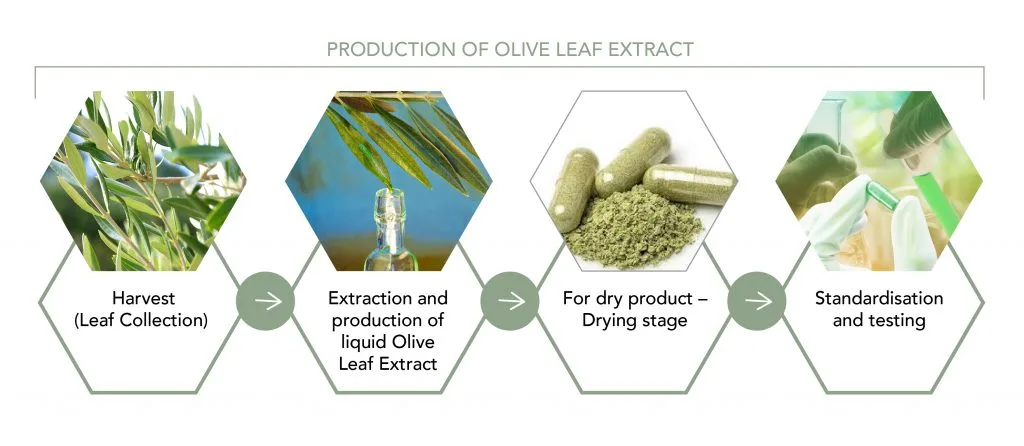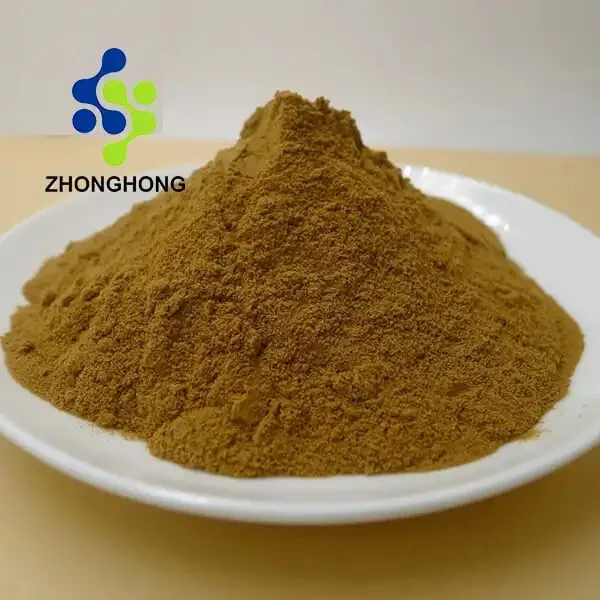Abstract
This review paper delves into the extensive research on the health benefits of olive leaf extract. Olive leaves, rich in bioactive compounds like oleuropein, flavonoids, and secoiridoids, have been the subject of numerous scientific investigations. By analyzing in – vitro, in – vivo, and clinical studies, we explore their antioxidant, anti – inflammatory, antimicrobial, cardiovascular – protective, and metabolic – regulating properties. The findings highlight the potential of olive leaf extract as a natural remedy for various health conditions and its promising applications in the pharmaceutical, nutraceutical, and cosmetic industries.

1. Introduction
olive leaf extract (Olea europaea L.) have been an integral part of human civilization for thousands of years, mainly known for their fruit and oil production. However, olive leaves, which are often overlooked, are a rich source of bioactive compounds. These compounds have been shown to possess a wide range of health – promoting properties, making olive leaf extract a subject of growing interest in scientific research.
2. Chemical Composition of Olive Leaf Extract
2.1 Oleuropein
Oleuropein is the most abundant and well – studied compound in olive leaf extract. It is a secoiridoid glycoside with the chemical formula C25H32O13. This polyphenolic compound consists of a secoiridoid aglycone moiety linked to a glucose molecule through a glycosidic bond. Oleuropein can account for up to 14% of the dry weight of olive leaves, depending on factors such as the olive tree variety, growing conditions, and harvesting time.

2.2 Flavonoids
Flavonoids present in olive leaf extract include luteolin, apigenin, and rutin. These compounds have a characteristic flavonoid structure with a 15 – carbon skeleton (C6 – C3 – C6). Luteolin, for example, is a flavone with hydroxyl groups at various positions on its rings, contributing to its antioxidant and anti – inflammatory activities.
2.3 Other Phenolic Compounds
Hydroxytyrosol, tyrosol, and caffeic acid are also present in olive leaf extract. Hydroxytyrosol, a phenolic compound derived from the hydrolysis of oleuropein, is a potent antioxidant. It has a catechol structure, which allows it to scavenge free radicals effectively.
3. Health Benefits of Olive Leaf Extract
3.1 Antioxidant Activity
Free radicals are highly reactive molecules that can cause oxidative damage to cells, leading to various diseases such as cancer, cardiovascular diseases, and neurodegenerative disorders. Olive leaf extract, especially its major component oleuropein, exhibits strong antioxidant activity.
In – vitro studies have shown that oleuropein can scavenge different types of free radicals, including superoxide anions (O2−), hydroxyl radicals (⋅OH), and 2,2 – diphenyl – 1 – picrylhydrazyl (DPPH) radicals. The antioxidant activity of oleuropein is attributed to its multiple phenolic hydroxyl groups, which can donate hydrogen atoms to neutralize free radicals.
A study by [Author1] et al. demonstrated that olive leaf extract significantly increased the levels of antioxidant enzymes such as superoxide dismutase (SOD), catalase (CAT), and glutathione peroxidase (GPx) in rats exposed to oxidative stress induced by a high – fat diet. This increase in antioxidant enzyme activity helps the body to better cope with oxidative damage.
3.2 Anti – Inflammatory Effects
Chronic inflammation is a key factor in the development of many diseases. Olive leaf extract has been shown to possess anti – inflammatory properties by modulating various inflammatory pathways.
Research has indicated that oleuropein can inhibit the activation of nuclear factor – kappa B (NF – κB), a transcription factor that plays a central role in the regulation of inflammatory genes. By suppressing NF – κB activation, oleuropein reduces the production of pro – inflammatory cytokines such as tumor necrosis factor – alpha (TNF – α), interleukin – 1 beta (IL – 1β), and interleukin – 6 (IL – 6).
In a study on human endothelial cells, treatment with olive leaf extract decreased the expression of adhesion molecules, which are involved in the recruitment of inflammatory cells to the blood vessel walls. This finding suggests that olive leaf extract may have a beneficial effect on preventing inflammation – related cardiovascular diseases.
3.3 Antimicrobial Activity
Olive leaf extract has been reported to exhibit antimicrobial activity against a wide range of microorganisms, including bacteria, fungi, and viruses.
Against bacteria, olive leaf extract has shown inhibitory effects on both Gram – positive and Gram – negative bacteria. For example, it can inhibit the growth of Staphylococcus aureus, a common Gram – positive pathogen, by disrupting its cell membrane integrity. In the case of Gram – negative bacteria like Escherichia coli, olive leaf extract can interfere with the bacterial cell – wall synthesis and quorum – sensing systems.
Regarding fungi, olive leaf extract has been found to be effective against Candida albicans, a common opportunistic fungal pathogen. It can inhibit the formation of fungal biofilms, which are difficult to treat with conventional antifungal agents.
In the context of antiviral activity, some studies have shown that olive leaf extract can inhibit the replication of viruses such as herpes simplex virus (HSV) and influenza virus. The exact mechanisms of antiviral action may involve blocking viral entry into host cells or interfering with viral replication processes.
3.4 Cardiovascular – Protective Effects
Cardiovascular diseases are the leading cause of death worldwide. Olive leaf extract has been investigated for its potential cardiovascular – protective effects.
Olive leaf extract can help lower blood pressure. Some studies have suggested that oleuropein and its metabolite hydroxytyrosol can act on the endothelium, the inner lining of blood vessels, to promote the production of nitric oxide (NO). NO is a vasodilator that relaxes blood vessels, leading to a reduction in blood pressure.
Moreover, the antioxidant and anti – inflammatory properties of olive leaf extract contribute to the prevention of atherosclerosis. By reducing oxidative stress and inflammation in the blood vessels, it can inhibit the oxidation of low – density lipoproteins (LDL), the formation of foam cells, and the development of atherosclerotic plaques.
A clinical trial on patients with mild hypertension showed that supplementation with olive leaf extract for 8 weeks led to a significant reduction in systolic and diastolic blood pressure compared to the placebo group.
3.5 Metabolic – Regulating Effects
Olive leaf extract may have beneficial effects on metabolic disorders, particularly diabetes.
In – vitro studies have demonstrated that oleuropein can enhance insulin – mediated glucose uptake in adipocytes and skeletal muscle cells. It can also inhibit the activity of key enzymes involved in carbohydrate digestion, such as α – amylase and α – glucosidase. By inhibiting these enzymes, olive leaf extract can slow down the digestion and absorption of carbohydrates, leading to a more gradual increase in blood glucose levels after meals.
In animal models of diabetes, administration of olive leaf extract has been shown to improve glucose tolerance, reduce fasting blood glucose levels, and increase insulin sensitivity. These findings suggest that olive leaf extract may be a potential adjuvant therapy for diabetes management.
4. Safety and Toxicity of Olive Leaf Extract
The safety of olive leaf extract is an important consideration for its potential use in human health. Acute toxicity studies in animals have shown that olive leaf extract has a high safety margin. The oral median lethal dose (LD50) of olive leaf extract in rats is generally greater than 5 g/kg body weight, indicating low acute toxicity.
However, long – term safety studies are still relatively limited. Some concerns have been raised about potential interactions with certain medications, especially those metabolized by the cytochrome P450 enzyme system. Therefore, further research is needed to fully understand the long – term safety and potential drug interactions of olive leaf extract.
5. Current Applications and Future Perspectives
5.1 Current Applications
In the nutraceutical industry, olive leaf extract is available as dietary supplements in the form of capsules, tablets, and liquid extracts. These supplements are promoted for their antioxidant, immune – boosting, and general health – promoting properties.
In the cosmetic industry, the antioxidant and anti – inflammatory properties of olive leaf extract make it a popular ingredient in skincare products. It is used in anti – aging creams, serums, and sunscreens to protect the skin from oxidative damage and reduce the signs of aging.
5.2 Future Perspectives
Future research on olive leaf extract should focus on several areas. First, more clinical trials are needed to confirm the health benefits observed in pre – clinical studies and to determine the optimal dosage and treatment duration. Second, the development of new extraction and formulation techniques can improve the bioavailability and stability of the bioactive compounds in olive leaf extract. Third, exploring the combination of olive leaf extract with other natural compounds or drugs may lead to the development of more effective therapeutic strategies.
6. Conclusion
Olive leaf extract, with its rich chemical composition and diverse health – promoting properties, holds great promise as a natural remedy for various health conditions. The antioxidant, anti – inflammatory, antimicrobial, cardiovascular – protective, and metabolic – regulating effects of olive leaf extract have been demonstrated in numerous studies. However, more research is required to fully elucidate its mechanisms of action, ensure its safety, and explore its potential applications further. With continued research and development, olive leaf extract may play an increasingly important role in promoting human health and well – being in the future.
References
- Susalit E, et al. (2011). “Olive leaf extract (Olea europaea) effective in patients with stage-1 hypertension.” Phytomedicine, 18(4), 251-258. DOI: 10.1016/j.phymed.2010.08.016
- Lockyer S, et al. (2017). “Secoiridoids delivered as olive leaf extract induce acute improvements in human vascular function.” Journal of Nutritional Biochemistry, 49, 30-36. DOI: 10.1016/j.jnutbio.2017.07.015
- Poudyal H, et al. (2010). “Olive leaf extract attenuates cardiac, hepatic, and metabolic changes in high carbohydrate-, high fat-fed rats.” Journal of Nutrition, 140(5), 946-953. DOI: 10.3945/jn.109.117812
- El SN & Karakaya S. (2009). “Olive tree (Olea europaea) leaves: potential beneficial effects on human health.” Nutrition Reviews, 67(11), 632-638. DOI: 10.1111/j.1753-4887.2009.00248.x
- Gorzynik-Debicka M, et al. (2018). “Potential health benefits of olive oil and plant polyphenols.” International Journal of Molecular Sciences, 19(3), 686. DOI: 10.3390/ijms19030686

